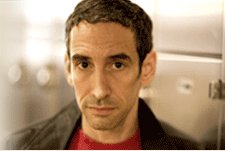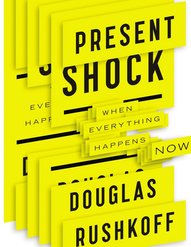Brands
Lessons From ‘Present Shock’ for Content Producers
One of the most formidable challenges for contemporary writers, editors and publishers is grappling with what author Douglas Rushkoff calls “present shock.”

Douglas Rushkoff
The term, also the title of his just-published book, describes “the human reaction to living in a real-time, instantaneous, simultaneous, always on, timeless, goalless, post-linear reality.”
Rushkoff’s concept is an updating of Alvin Toffler’s 70’s classic book Future Shock, in which he urged us to get used to an ever-accelerating future. To Rushkoff, the future has accelerated to the point where we are engulfed in a metastasized and all-consuming present.
For all of the media opportunities these changes have brought, the central point of value in publishing — the capturing of the reader or viewer’s attention — has become harder and harder to achieve. This is not just a mater of “information overload,” but what internet theorist Clay Shirky calls “filter failure.”
Contemporary audiences seem unable to understand, in Rushkoff’s words, that “Whatever is vibrating on the iPhone just isn’t as valuable as the eye contact you are making right now.”
Rushkoff gave a talk last month at the O’Reilly Tools of Change conference in New York. He was addressing mainly book publishers, but his points apply to all content producers.
“Digital is as different from the mechanical, industrial age book as the book is from the biblical age scroll,” he told the audience. “It’s that different, and that’s why we’re kind of freaked out.”
Writing for the digital universe involves different forms of temporal and conceptual compression and finding the right balance is critical. For instance, you shouldn’t spend six months crafting a tweet, Rushkoff suggests.
 Because “The digital happens in the now,” we are constantly catering to readers — and instantaneously monitoring the results. “Everything is a la carte in a digitally-dominated, present shock universe,” Rushkoff says, “in one where people want to be able to make a choice at every single place.” But all of that choice may not in fact be such a good thing.
Because “The digital happens in the now,” we are constantly catering to readers — and instantaneously monitoring the results. “Everything is a la carte in a digitally-dominated, present shock universe,” Rushkoff says, “in one where people want to be able to make a choice at every single place.” But all of that choice may not in fact be such a good thing.
“The problem with reading in that way,” Rushkoff argues, “is that people end up reading in order to dismiss .… They don’t read a magazine or book in order to get what’s on the page, they read it in order to feel entitled to dismiss what’s on the page.” Like the high school student who reads the SparkNotes about Hamlet to get the gist of “To be or not to be,” present shock readers are moving too fast to metabolize the feast we want to put before them.
As a writer of long-form books (14 at last count) Rushkoff wants to engage the present moment by helping readers slow it down. “What I am arguing for is that what books are — and what books can be in this next era of publishing — are these extended experiences of voluntary non-agency, where we surrender our authority to an author.”
And this is relevant for magazines, newspapers and online content as well. Our work ceases to be just a commodity when someone reads it because we wrote it, or because our brand published it. The writer’s voice needs to count more than the first Google result. “Our challenge now is how do we show people that making that choice is actually engaging and entertaining — and valuable,” concludes Rushkoff.
The lessons for content producers are clear. Develop unique voices and explore innovative angles on familiar material. Speak of the new with the authority of history. Do not let the rush of time hurry you into generic expression. Understand the right level of compression for you medium. Be timely when required and reflective when not. As Polonius says in Hamlet’s first act, “To thine own self be true.”

Get better at your job right now.
Read our monthly newsletter to master content marketing. It’s made for marketers, creators, and everyone in between.




